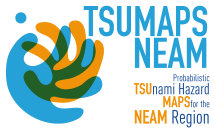The goal of Tsunami Modelling is to provide the necessary tool for assessing the impact at the target coastline of the tsunamis corresponding to all the earthquake scenarios considered in the earthquake model.
Given the regional character of the TSUMAPS-NEAM PTHA, the problem of tsunami generation and propagation up to the 50m depth isobaths will be numerically solved in the framework of linear elastic theory and linear long wave propagation assumptions.
A tsunami unit-source database, providing the tsunami impact corresponding to an initial Gaussian-shaped sea level elevation, is already available as a product of ASTARTE and Italian national PTHA. Methods for quantifying the uncertainty introduced by such an approximation are being developed as well, and will be applied in TSUMAPS-NEAM. This database is presently being extended to most of NEAM source region in the ASTARTE project. It will be completed in TSUMAPS-NEAM, by means of HySEA, a fast and benchmarked tsunami code developed by Malaga University.
The tsunami database enables linear superposition of tsunamis induced by unit-sources to get the effect due to any scenario in the earthquake model, at all points of interest along NEAM coastlines. In this way, the limited number of unit-sources may be combined to provide a much larger number of larger and more complex tsunami scenarios.
The relevant tsunami hazard intensity (such as runup or flowdepth) will be then obtained by means of a wellestablished approximation (e.g. used in GAR15) based on shoaling amplification factors depending on the local shape of the bathymetry. The amplification factors will be further optimized for use in the relevant NEAM regions. Linear superposition of tidal stages probability will be taken into account where relevant (e.g. Atlantic coast). Epistemic uncertainty on tsunami modelling will be assessed as a function of the source parameters, or using well-established empirical characterizations of the Probability Density Function (PDF) of observed tsunami runup.
